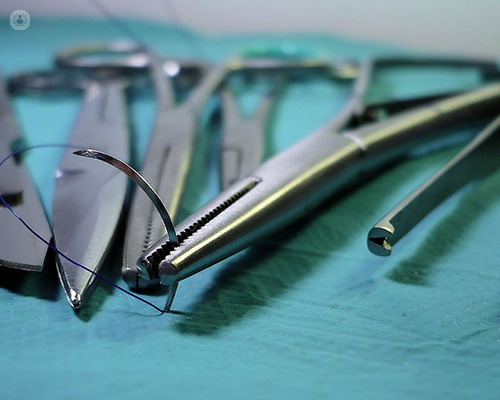Through the keyhole; laparoscopy explained
Written in association with:Laparoscopy, or keyhole surgery, can have enormous benefits for patients over traditional surgery, delivering shorter hospital stays, less pain, and reduced scarring. Here we talk to Mr Charles Imber, an expert based at the London Digestive Center, about laparoscopic surgery including what it involves and its major benefits.

What is laparoscopic surgery?
Laparoscopic surgery is a form of minimally invasive surgery, rather than the old-fashioned type of surgery where we would make a large cut on the abdominal cavity and a surgeon and his assistant would place their hands inside the abdomen. In laparoscopic surgery, we’re using a number of smaller incisions into which ports are placed and then instruments or cameras can be placed through those ports to enable the operation. The surgeon’s looking at a TV screen, usually above the patient and instruments are being utilized above the patient’s abdomen so that the surgeon can then go ahead with the operation. We can introduce things that can cut tissue, stop bleeding and join tissue together, enabling us to do a whole host of different operations from minor surgery to more advanced techniques.
When is laparoscopic surgery recommended?
We utilize this type of minimally invasive technique depending on patient factors and also depending on the operation we’re doing. If patients have had previous abdominal surgeries, sometimes it can be difficult to use laparoscopic techniques.
We’d often use it for more minor operations. Things like removal of a gallbladder, hernia repairs (both in the groin and in the abdominal wall) and also increasingly for more complex operations; potentially the removal of part of the pancreas gland, spleen, or even for sometimes things like liver resection where we’re removing a tumor from the part of the liver.
What does laparoscopic surgery involve?
This type of surgery is performed under general anesthetic. It would normally involve making a small cut somewhere around the belly button of about a centimeter through which a port and then a camera can be placed and gas can be introduced into the abdominal cavity. We then place a number of smaller incisions in different areas of the abdomen depending on what operation we’re performing.
For example, if we’re doing a removal of a gallbladder or a so-called laparoscopic cholecystectomy, we would make a small cut by the belly button and then three smaller cuts in the top of the tummy—one in the midline and two on the right side. We then introduce instruments into those ports and we’re able to disconnect the gallbladder from the liver and the surrounding bile ducts and then place the gallbladder in a bag so that it can be removed from the umbilical cords. We then make sure that there is no bleeding in the abdomen and no collections of abnormal fluid and we can then release the gas from the tummy, remove the ports, and close the abdominal wounds. The patients will often go on the same day or day after surgery, with very little pain after the operation.
What are the benefits of laparoscopic surgery?
The major benefits for the patient are in terms of the way they recover from an operation. If you think about old-fashioned incisions, where a large cut would often be placed on the abdominal wall, which went through the muscle, so that the surgeon could put a hand on the abdomen, would create a lot of pain for the patients and it would delay their discharge from hospital for several days. It would also mean that the patient would require very strong painkillers which were often morphine based and came with side effects. Those wounds have a high chance of becoming infected or even forming hernias in the future.
One of the benefits of laparoscopic surgery that the incisions are very small, which creates very little pain for the patient when they wake up from surgery, which in turn means much less requirement for strong painkillers. The patient can be up and mobilizing very quickly after the operation and sometimes can be discharged the same day, depending on the recovery and the type of operation they’re having.
Laparoscopic surgery is also advantageous for the surgeon in certain operations. For example, in a larger patient where we try to do a gallbladder operation through a small open incision, it can actually be quite difficult to visualize the important structures whereas the view that we attain with laparoscopic surgery enhances the ability to do the operation safely.


